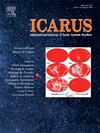Water production rates from SOHO/SWAN observations of Comets C/2017 K2 (PanSTARRS) and C/2022 E3 (ZTF)
IF 3
2区 物理与天体物理
Q2 ASTRONOMY & ASTROPHYSICS
引用次数: 0
Abstract
In 2022 and 2023 the hydrogen comae of two long period comets, C/2017 K2 (PanSTARRS) and C/2022 E3 (ZTF), were observed with the Solar Wind ANisotropies (SWAN) all-sky hydrogen Lyman-alpha camera on the SOlar and Heliosphere Observer (SOHO) satellite. SWAN obtains nearly daily full-sky images of the hydrogen Lyman-alpha distribution of the interstellar hydrogen as it passes through the solar system yielding information about the solar wind and solar ultraviolet fluxes that eat away at it by ionization and charge exchange. The hydrogen comae of comets, when of sufficient brightness, are also observed. Water production rates have been calculated over time for each of these comets, covering about 6 months mostly of the post-perihelion period of C/2017 K2 (PanSTARRS) and about 3 months around perihelion of C/2022 E3 (ZTF).
SOHO/SWAN观测彗星C/2017 K2 (PanSTARRS)和C/2022 E3 (ZTF)的产水速率
在2022年和2023年,利用SOHO (Solar and Heliosphere Observer)卫星上的“太阳风各向异性”(SWAN)全天候氢Lyman-alpha相机,对C/2017 K2 (PanSTARRS)和C/2022 E3 (ZTF)两颗长周期彗星的氢彗发进行了观测。SWAN几乎每天都能获得星际氢在穿越太阳系时的莱曼α分布的全天图像,从而获得太阳风和太阳紫外线通量的信息,这些信息是通过电离和电荷交换来吞噬它的。当彗星有足够的亮度时,也可以观察到彗星的氢彗发。随着时间的推移,这些彗星的产水率已经被计算出来,覆盖了C/2017 K2 (PanSTARRS)近日点后大约6个月的时间,以及C/2022 E3 (ZTF)近日点前后大约3个月的时间。
本文章由计算机程序翻译,如有差异,请以英文原文为准。
求助全文
约1分钟内获得全文
求助全文
来源期刊

Icarus
地学天文-天文与天体物理
CiteScore
6.30
自引率
18.80%
发文量
356
审稿时长
2-4 weeks
期刊介绍:
Icarus is devoted to the publication of original contributions in the field of Solar System studies. Manuscripts reporting the results of new research - observational, experimental, or theoretical - concerning the astronomy, geology, meteorology, physics, chemistry, biology, and other scientific aspects of our Solar System or extrasolar systems are welcome. The journal generally does not publish papers devoted exclusively to the Sun, the Earth, celestial mechanics, meteoritics, or astrophysics. Icarus does not publish papers that provide "improved" versions of Bode''s law, or other numerical relations, without a sound physical basis. Icarus does not publish meeting announcements or general notices. Reviews, historical papers, and manuscripts describing spacecraft instrumentation may be considered, but only with prior approval of the editor. An entire issue of the journal is occasionally devoted to a single subject, usually arising from a conference on the same topic. The language of publication is English. American or British usage is accepted, but not a mixture of these.
 求助内容:
求助内容: 应助结果提醒方式:
应助结果提醒方式:


